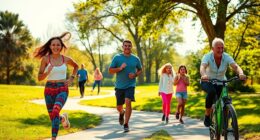When a volcano erupts, pressure builds up inside magma chambers, fueling explosive events as buoyant forces push molten rock upwards. The rise of magma, accumulating in chambers beneath the surface, can lead to these awe-inspiring natural occurrences. Gas pressure and magma density also play pivotal roles in triggering volcanic eruptions, while magma viscosity determines eruption types. Understanding these fundamental factors is essential for predicting the intensity and behavior of volcanic events. Explore more about the intricate science behind what causes volcanoes to erupt and unravel the secrets of these powerful geological phenomena.
Key Takeaways
- Magma buoyancy due to its lower density drives it to rise towards the surface.
- Gas pressure within magma chambers builds up, influencing eruption behavior.
- Pressure from trapped gases can lead to explosive volcanic eruptions.
- Magma viscosity, influenced by silica content, determines eruption types.
- Understanding magma density, gas pressure, and viscosity are crucial for predicting eruption intensity.
Magma Movement and Accumulation
Understanding how magma moves and accumulates beneath a volcano is essential for predicting eruptions. Magma, molten rock beneath the Earth's surface, is buoyant, causing it to rise towards the volcano. As magma ascends, it accumulates in chambers beneath the volcano. The pressure within these magma chambers increases as more magma and exsolved gases are trapped, potentially leading to volcanic eruptions.
The movement of magma is influenced by various factors, including buoyancy and the pressure exerted by exsolved gases. As magma rises, the pressure from these gases can drive it towards the surface, increasing the likelihood of an eruption. Additionally, injections of new magma into existing chambers can further elevate the pressure, hastening the volcanic activity.
Ultimately, the understanding of how magma moves and accumulates is fundamental in volcanic research. By monitoring these processes, scientists can better predict eruptions and mitigate potential hazards posed by volcanic activity.
Pressure Factors in Eruption

Magma buoyancy, gas pressure, and chamber lid pressure play vital roles in triggering volcanic eruptions. When magma rises towards the surface, its lower density compared to the surrounding rocks allows it to ascend. The dissolved gases within magma exert pressure, influencing the behavior of volcanic eruptions. Pressure buildup within magma chambers can lead to explosive volcanic activities, shaping the intensity and style of the eruption. Understanding the intricate pressure dynamics at play is essential for accurately predicting and studying volcanic events.
To visualize the significance of pressure factors in volcanic eruptions, let's explore a comparison table showcasing the key elements involved:
| Pressure Factor | Description | Impact on Eruption |
|---|---|---|
| Magma Buoyancy | Magma's lower density | Facilitates upward movement |
| Gas Pressure | Dissolved gases in magma | Influences eruption behavior |
| Chamber Lid Pressure | Pressure buildup in chambers | Can lead to explosive eruptions |
Role of Magma Density

The density of magma greatly influences the movement and behavior during volcanic eruptions. Less dense magma plays a pivotal role in the eruption process as it rises towards the surface. This lower density compared to surrounding rocks allows the magma to ascend through cracks and vents, ultimately leading to volcanic eruptions.
Buoyancy, which is influenced by the density of the magma, drives the upward movement of magma towards the Earth's surface. Understanding magma density is crucial for predicting eruption behavior and volcanic hazards accurately.
Changes in magma density can have a significant impact on the likelihood and intensity of volcanic eruptions, making it a vital factor to take into account in volcanic studies. By examining the density of the magma, scientists can gain valuable insights into the dynamics of volcanic eruptions and enhance their ability to forecast and mitigate associated risks effectively.
Impact of Gas Pressure

Gas pressure, influenced by dissolved volatiles like water, sulfur dioxide, and carbon dioxide, plays a crucial role in triggering volcanic eruptions. When these gases are dissolved in magma within magma chambers, the pressure gradually builds up. As the magma rises towards the surface, the decrease in pressure causes the gases to separate from the magma, forming bubbles.
This separation increases the pressure within the volcanic conduits. The high gas/magma ratios in these conduits contribute significantly to the explosiveness of volcanic eruptions.
Understanding the impact of gas pressure is essential for predicting the intensity and type of volcanic eruptions. Explosive volcanic activity, characterized by violent eruptions ejecting ash, gases, and rock fragments, is often a result of high gas pressures within the magma. By studying the dissolved gases, scientists can gain insights into the behavior of volcanoes and improve their ability to forecast eruptions accurately.
Gas pressure is a key factor that must be taken into account in volcanic monitoring and hazard assessment.
Viscosity and Eruption Types

Understanding the viscosity of magma is vital for determining the types of volcanic eruptions that occur. Magma viscosity plays a pivotal role in shaping eruption behavior and the associated volcanic hazards. Here's why:
- Magma Viscosity: Determines the flow characteristics of magma, influencing eruption types.
- Effusive Eruptions: Occur with low-viscosity magma, resulting in steady lava flows.
- Explosive Eruptions: Caused by high-viscosity magma, leading to fragmented magma, ash, and pyroclastic flows.
- Silica Content: Affects magma viscosity, with higher silica content increasing viscosity and potential explosivity.
Frequently Asked Questions
What Causes an Eruption From a Volcano?
When a volcano erupts, it's due to the magma's buoyancy, gas pressure, and pressure buildup beneath a chamber. Magma's lower density makes it rise, while gases like water and carbon dioxide affect eruption behavior. Understanding these factors is essential.
What Caused This Volcano to Erupt?
Wondering what caused this volcano to erupt? Factors like magma buoyancy, gas pressure, and chamber lid pressure play a key role. Magma's rise due to density, dissolved gases, and new injections trigger these explosive events.
What Is the Explanation of Volcanic Eruption?
When a volcano erupts, it's due to rising magma breaking through the Earth's crust. Factors like magma's buoyancy, gas pressure, and chamber lid pressure trigger these events. Understanding these causes helps predict and manage volcanic hazards.
What Are the Three Main Causes of Volcanic Eruptions?
Feeling the earth's heartbeat beneath you, three forces collide: magma's rise, gas's push, and a chamber's lid. These powers dance unseen, shaping fiery mountains. Understand them, predict danger, and stay safe.
Conclusion
So, now you know what causes a volcano to erupt! Remember, magma movement and accumulation, pressure factors, magma density, gas pressure, and viscosity all play a role in triggering volcanic eruptions.
Did you know that there are about 1,500 potentially active volcanoes worldwide? Stay curious and keep learning about the fascinating science behind these powerful natural phenomena!










